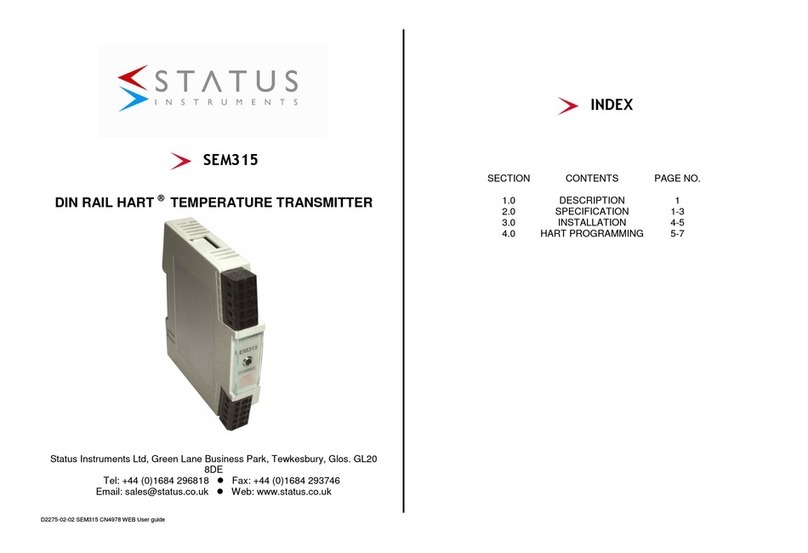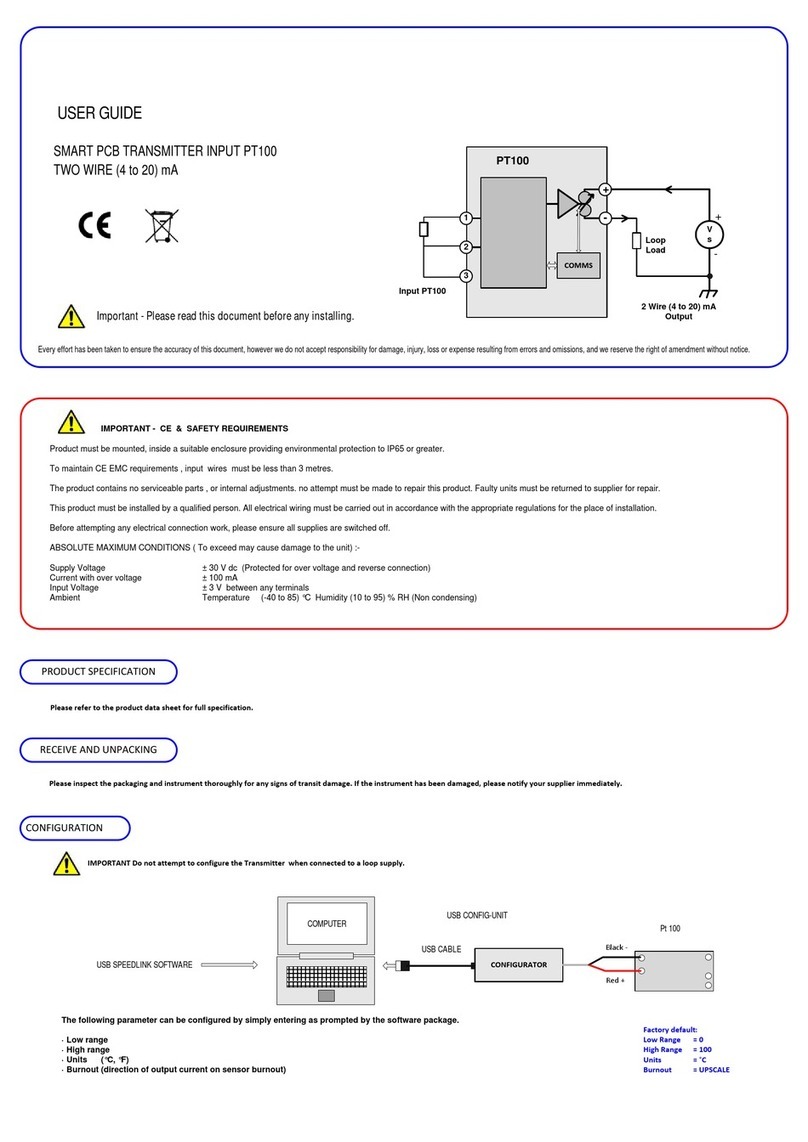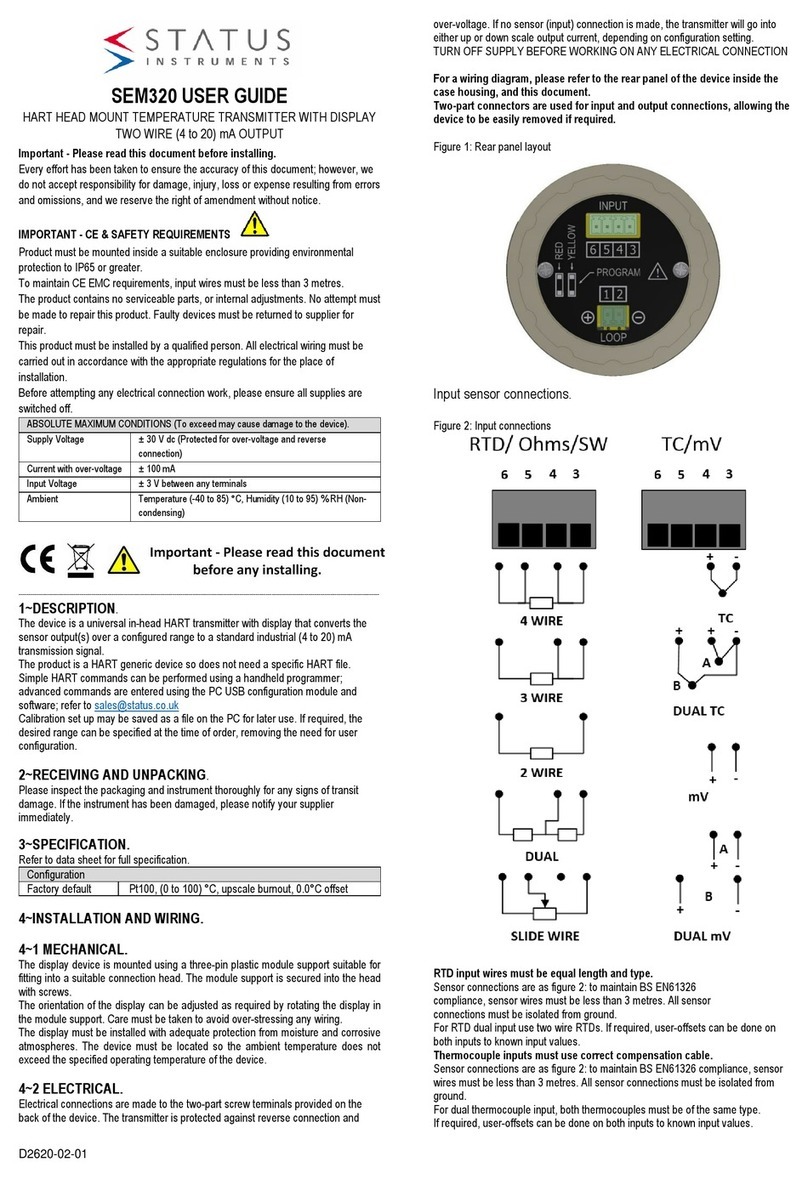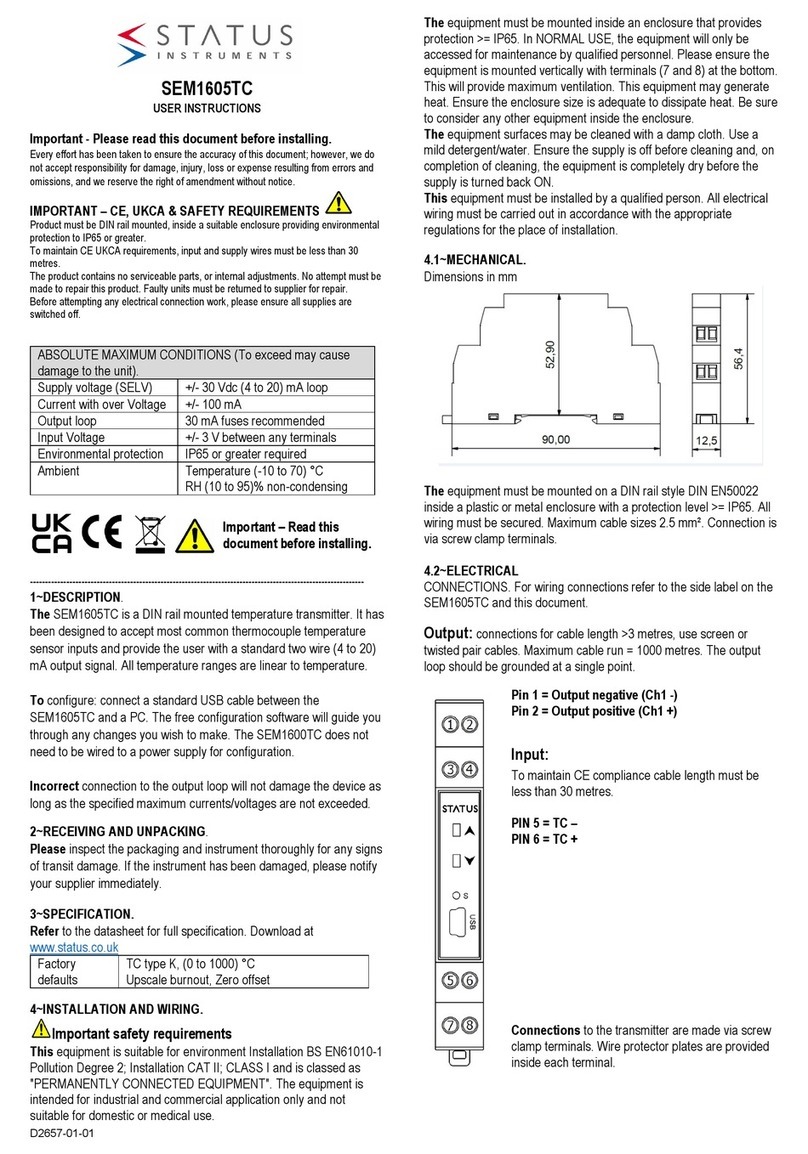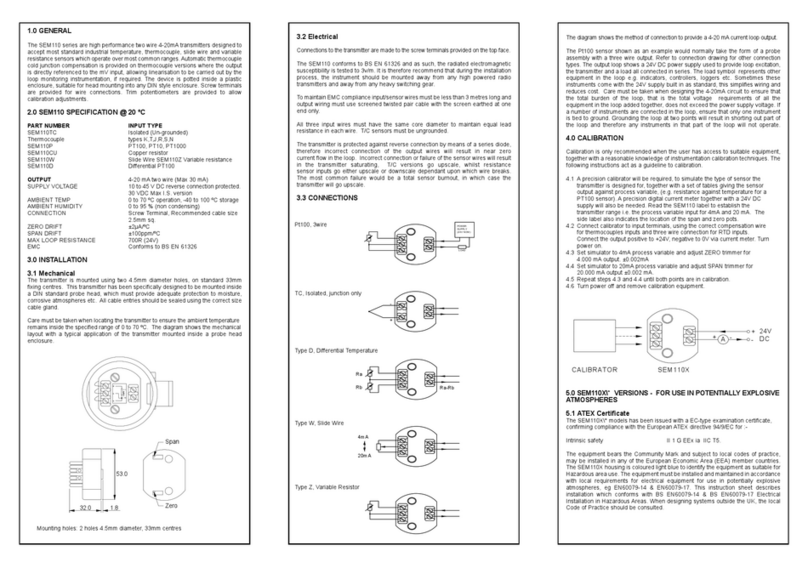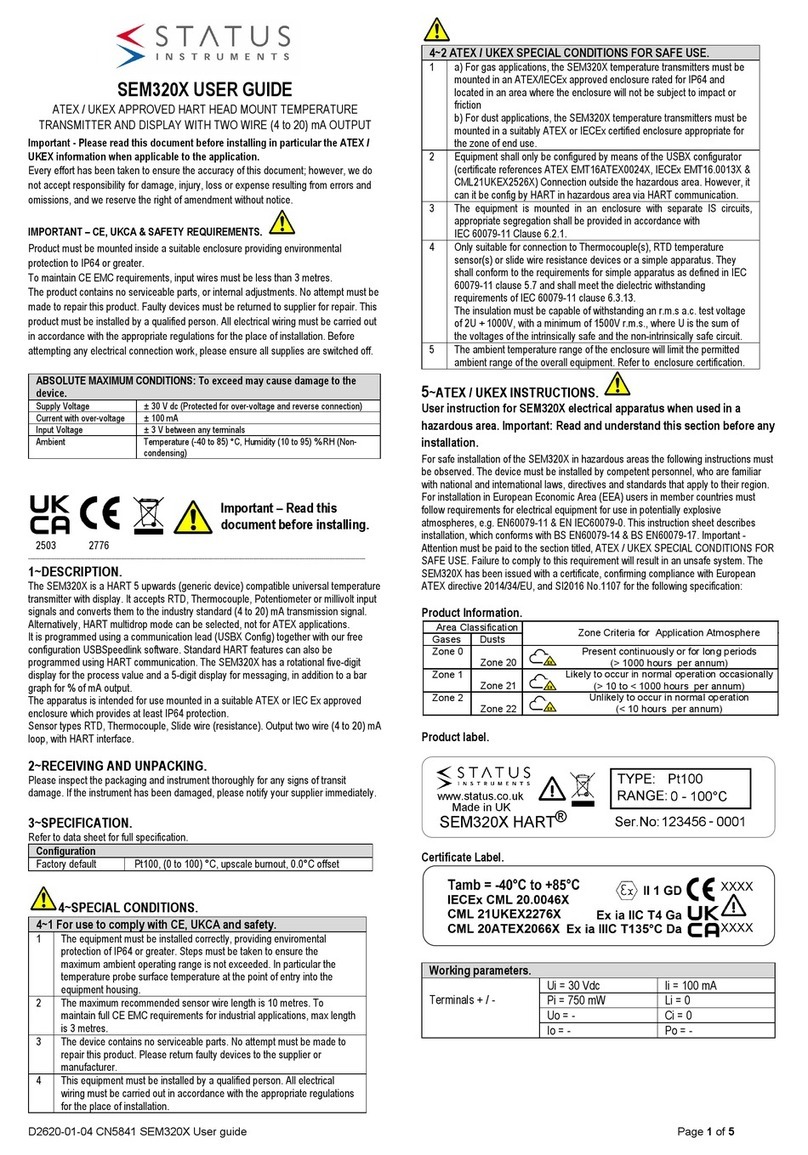Every effort has been taken to ensure the accuracy of this specification, however we do
not accept responsibility for damage, injury, loss or expense resulting from errors and
omissions, and we reserve the right of amendment without notice.
PO Box 548, 456 Park Ave.,
Scotch Plains, NJ 07076
P: (908) 490-0232 P: (800) 700-3272
F: (800) 700-5468 E: bm@statinst.com
www.statinst.com
•
•
•
•
•
•
•
•
•
•
•
•
•
•
•
•
•
•
•
•
•
•
•
•
•
•
•
Navigating the menus (Read all of this section before attempting configuration)
To access the advanced user menus press and hold down button during
SEM203TC power up. The advance user menus will now be enabled and remain
enabled until transmitter power is removed. Note the “USER RANGING: level will
not be active at this stage, the push button will now serve to navigate “advance
user menus” as follows:
Configuration will require the following tools and equipment:
To “enter” menus press and hold button for > 2 seconds. The “M” LED will
then start to flash, rate one flash per burst (indicating menu 1).
To “advance” to the next menu use single button press, the “M” LED will
advance to two flashes per burst, indicating menu 2 is selected. Repeated
single presses will advance menu, once menu 5 is reached, the next press
will return to menu 1, for a repeat cycle around the menus.
To “escape” from menus back to normal operation use a double click of the
button or remain selected indefinitely.
To “enter” a selected menus press and hold button for two seconds, at which
stage the “R” LED will start to flash between burst of the “M” LED, indicating
the state of the opened menu.
MENUS (First Select the required menu and open as described above.)
Menu 1 Input type
On “Entry” - “M” LED single flash every burst (menu 1), followed by a burst
of between 1 to 8 “R” LED flashes, flash count represents the input type as
listed below. Timeout is 10 seconds so be sure to act quickly if the type needs
changing.
5.0 ADVANCED USER CONFIGURATION
The advanced user configuration option is based on five menus, each menu sets
a different parameter:
Menu 1 Selects one of eight input types.
Menu 2 Selects either custom user range or one of seven fixed ranges
Menu 3 Selects the output direction of sensor burnout
Menu 4 Provide User trim at 4mA and 20mA.
Menu 5 Reset to factory default setting
The advance configuration menus are navigated using the push button, menu
“M” LED and range “R” LED. The push button is located underneath the slot in
the key hole label, located just below the “M” LED. To press the button use a 3
mm screw driver (flat blade) inserted into the slot. The button has a slight click
action.
Three commands are used to navigate menus, performed by clicking the button
as follows:
• Advance Single button press or click
• Escape or change direction Double press or click within 0.5 seconds
• Enter Press and hold button > two seconds
When a menu is selected the “M” LED will flash a burst of 1 to 5 flashes, the
number of flashes represents the menu number.
Note: The range “R” LED will only operate when a selected menu has been
entered, then the “R” LED uses a series of flashes or toggle flash rates to indi-
cate the state or stage of the open menu.
“R” LED flashes Input Type
1 Type K
2 Type J
3 Type E
4 Type N
5 Type T
6 Type R
7 Type S
8mV
4.0 USER RANGING (con’t)
Allow 1 minute warm up period.
To “enter” ranging, press and keep pressed the push button until Range “R”
LED flashes at a slow rate for approximately one second during which period
the low scale range is stored. Once the store is complete the “R” LED will
flash at a medium rate indicating the transmitter is ready to store the high
range setting.
Set the calibrator to the required high range temperature and allow ten sec-
onds.
Press button and release to store high range setting, the “R” LED will flicker
for one second before the transmitter returns to normal operation. The trans-
mitter is now re-ranged.
The above procedure also applied to mV input, but please ensure only copper
wire is used for connection to mV calibrator.
Once the desired type is selected, allow 10 seconds with no button action, the transmit-
ter will then store the selected input type, (indicated by flicker of “R” LED) before return
back to normal operation.
Menu 2 Fixed ranges
On “Entry” the “M” LED flashes twice every burst (menu 2), followed by a “R” LED flash-
es between 1 to 8, flash count represents the range selected as described below.
Timeout is 10 seconds so be quick to act.
Range 1 is allocated for the user custom push button set range. When a new custom
range (see USER RANGING) is entered, the range selected will automatically return to 1.
•
Single button press to “advance” to the next input type, when type 8 is
reached the next “advance” will cycle back to type 1. To ensure valid indica-
tion of input menu, allow one to two burst cycle after “advance”, before
counting the “R” LED flashes.
Range “R” Inputs Input Inputs Input mV
LED K, J, E, & N T R, & S
flashes (°C) (°C) (°C) mV
1User Ranged
2 0 to 1000 0 to 400 800 to 1760 0 to 70
3 0 to 1200 0 to 250 800 to 1600 0 to 5
4 0 to 600 0 to 200 800 to 1400 0 to 10
5 0 to 500 0 to 150 1000 to 1760 0 to 20
6 0 to 250 0 to 100 1000 to 1600 0 to 25
7 0 to 100 0 to 50 1000 to 1400 0 to 50
8 -100 to 100 -100 to 100 0 to 1600 -10 to 10
Single button press to “advance” to the next range, once range 8 is reached, the next
“advance” will cycle range back to 1. To ensure valid indication of range menu, allow one
to two burst cycle after “advance”, before counting flashes.
Once the desired range is selected allow for 10 seconds with no button action, the transmit-
ter will then store new range (indicated by flicker of “R” LED) before returning to normal
operation.
Menu 3 Burnout Selection
On “Entry” - “M” LED, three flash every burst (menu 3), followed by a “R” LED toggle
flash, either at a slow rate (every second) or a faster medium rate. Be quick to act as
timeout is 10 seconds.
Slow rate indicates downscale burnout, fast rate indicates upscale burnout.
To “advance” to the other burnout direction press button.
To store new setting allow 10 seconds with no button action, the burnout selection menu
will then timeout, store new setting, (indicated by a flicker of the “R” LED), before return-
ing back to normal operation.
Menu 4 User trim
This menu allows the user to trim the output current at zero and span, (similar function
to trim potentiometers) and is very useful for trimming out sensor errors.
The input of the transmitter must be connected to either a calibrator or a temperature
sensor held at a known temperature. The (4 to 20) mA loop current will also need to be
monitored with a current meter. This menu has extended timeout of 20 seconds.
The trim action will only operate within certain output current bands, the zero will be
trimmed when the out current is between (3.8 to 6.0) mA, and the span will be trimmed
when the output current is between (18.0 to 21.5) mA.
On “Entry” - “M” LED, four flash every burst (menu 4), followed by a “R” LED toggle flash,
either at a slow rate (every second) or a faster medium rate.
Slow rate indicates trim direct down, while fast rate indicates trim direction up.
To “change direction” the trim direction double click button.
To trim, single press button to “advance” current by 2 µA, or press and hold button to auto
advance, after two seconds the trim will adjust automatically at a rate of 3µA per second
until the button is released. Note, after approximately 20 seconds of continuous button
press, the auto trim rate will speed up to a rate of 10 µA per second.
To store a new setting allow 20 seconds with no button action, the User Trim menu will
then timeout and store any new setting(s), (indicated by a flicker of the “R” LED), before
returning back to normal operation.
Menu 5 Set factory default
On “Entry” - “M” LED, five flashes every burst (menu 5), followed by “R” LED toggle flash
at a slow rate (every second).
To set factory default and zero any user trim, press button. Default setting will then be
loaded and stored into the transmitter, indicated by a flicker of the “R” LED. The transmit-
ter will then return to normal operation.
To avoid any action, allow 10 seconds with no button action. Set factory default menu will
then timeout, without storing any default configuration. The transmitter will then return to
normal operation.






